英语教研评课记录
初中英语教研课评课记录(3篇)
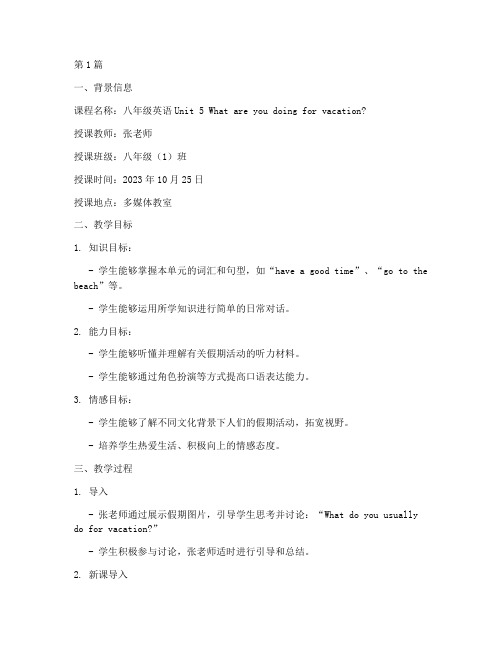
第1篇一、背景信息课程名称:八年级英语Unit 5 What are you doing for vacation?授课教师:张老师授课班级:八年级(1)班授课时间:2023年10月25日授课地点:多媒体教室二、教学目标1. 知识目标:- 学生能够掌握本单元的词汇和句型,如“have a good time”、“go to the beach”等。
- 学生能够运用所学知识进行简单的日常对话。
2. 能力目标:- 学生能够听懂并理解有关假期活动的听力材料。
- 学生能够通过角色扮演等方式提高口语表达能力。
3. 情感目标:- 学生能够了解不同文化背景下人们的假期活动,拓宽视野。
- 培养学生热爱生活、积极向上的情感态度。
三、教学过程1. 导入- 张老师通过展示假期图片,引导学生思考并讨论:“What do you usually do for vacation?”- 学生积极参与讨论,张老师适时进行引导和总结。
2. 新课导入- 张老师展示本单元的单词卡片,引导学生进行认读和拼写。
- 学生通过小组合作,互相纠正发音和拼写错误。
3. 课文讲解- 张老师带领学生逐句翻译课文,并对重点词汇和句型进行讲解。
- 学生跟读课文,巩固所学知识。
4. 听力练习- 张老师播放听力材料,引导学生听后回答问题。
- 学生通过听力练习,提高对英语语音、语调的感知能力。
5. 口语练习- 张老师组织学生进行角色扮演,模拟对话场景。
- 学生在角色扮演中,运用所学知识进行口语交流。
6. 课堂小结- 张老师对本节课所学内容进行总结,强调重点和难点。
- 学生复述本节课所学内容,巩固所学知识。
四、教学反思1. 教学亮点- 张老师教学设计合理,教学过程紧凑,能够充分调动学生的学习积极性。
- 张老师注重培养学生的口语表达能力,通过角色扮演等方式,提高学生的口语水平。
- 张老师善于引导学生进行小组合作,培养学生的团队协作能力。
2. 教学不足- 部分学生对新单词的掌握不够牢固,需要加强复习和巩固。
初中英语教研组记录评课(3篇)

第1篇一、会议时间:2022年3月15日二、会议地点:学校会议室三、参会人员:初中英语教研组成员四、会议主题:评课活动总结与教学反思一、会议流程1. 介绍本次评课活动的背景和目的2. 汇报本次评课活动的具体情况3. 各教研组成员对评课活动的总结与反思4. 针对评课活动中发现的问题提出改进措施5. 研讨下一步教学工作计划二、会议内容1. 介绍本次评课活动的背景和目的随着新课程改革的深入推进,初中英语教学质量成为了学校教育工作的重点。
为了提高英语教学质量,加强教师队伍建设,我校初中英语教研组决定开展本次评课活动。
本次评课活动的目的是通过观摩、研讨、反思,提高教师的教学水平,促进教师专业成长。
2. 汇报本次评课活动的具体情况本次评课活动共选取了三位教师的英语课进行观摩。
评课活动分为两个阶段:观摩和研讨。
观摩阶段:教研组成员观摩了三位教师的英语课,认真记录了课堂中的亮点和不足。
研讨阶段:教研组成员针对观摩到的英语课进行了深入的研讨,分别从教学目标、教学内容、教学方法、教学效果等方面进行了点评。
3. 各教研组成员对评课活动的总结与反思(1)张老师:本次评课活动让我受益匪浅。
在观摩其他教师的英语课时,我发现了他们在教学设计、教学方法、课堂管理等方面的优点。
同时,我也发现了自己教学中存在的问题,如课堂提问不够深入、学生参与度不高、教学评价方式单一等。
在今后的教学中,我将努力改进这些问题,提高自己的教学水平。
(2)李老师:在本次评课活动中,我深刻认识到教学设计的重要性。
观摩其他教师的英语课,我发现他们在教学设计方面做得非常出色,能够根据学生的实际情况和教学目标,设计出符合学生需求的教学活动。
在今后的教学中,我将更加注重教学设计,努力提高教学效果。
(3)王老师:在观摩其他教师的英语课时,我发现他们在课堂管理方面做得很好,能够有效地调动学生的学习积极性。
同时,我也认识到自己在课堂管理方面还有待提高。
在今后的教学中,我将借鉴其他教师的经验,加强课堂管理,提高学生的学习兴趣。
英语教研活动评课记录

活动时间:2023年4月15日活动地点:学校英语教研室参与人员:全体英语教研组成员活动主题:小学英语课堂活动设计与应用一、活动背景为了提升我校英语教师的教学水平和课堂活动设计能力,学校英语教研组于2023年4月15日组织了一次教研活动。
本次活动旨在通过观摩一位教师的公开课,对课堂活动设计进行深入探讨,并以此为契机,提升全体英语教师的教学素养。
二、活动过程1. 公开课观摩活动伊始,由我校青年教师李老师执教了一节小学英语三年级下册的公开课《My Family》。
李老师以“家庭”为主题,通过图片、视频、游戏等多种教学手段,激发了学生的学习兴趣,使学生在轻松愉快的氛围中掌握了新知识。
2. 评课环节观摩结束后,全体英语教研组成员进行了评课活动。
以下是部分评课记录:(1)李老师的教学设计:李老师的教学设计非常合理,她以学生为中心,注重培养学生的听说能力。
课堂活动丰富多样,如“Who am I?”、“Show me your family”等游戏,让学生在轻松愉快的氛围中学习英语。
(2)课堂活动设计:李老师的课堂活动设计富有创意,能够激发学生的学习兴趣。
例如,在“Show me your family”环节,她让学生通过展示家庭成员的照片,用英语介绍自己的家庭,既锻炼了学生的口语表达能力,又增进了学生对家庭的认识。
(3)教学效果:李老师的课堂氛围活跃,学生参与度高。
在课堂活动中,大部分学生能够积极回答问题,用英语进行表达。
教学效果显著,达到了预期的教学目标。
3. 总结与反思在评课环节结束后,教研组长对本次活动进行了总结。
她认为,李老师的公开课充分展示了英语教师的教学风采,同时也为我们提供了宝贵的经验。
以下是总结与反思:(1)课堂活动设计应注重趣味性与实用性相结合,激发学生的学习兴趣。
(2)教师应关注学生的个体差异,因材施教,使每个学生都能在课堂上有所收获。
(3)英语教学应注重听说读写四项技能的培养,使学生全面发展。
英语教研活动听评课记录

活动时间:2023年11月15日活动地点:XX中学英语组办公室活动主题:基于核心素养的英语阅读教学策略探讨参与人员:英语教研组全体教师听课教师:张老师授课班级:八年级(2)班一、课堂基本情况本次教研活动由张老师执教八年级(2)班的英语阅读课。
课程内容为《牛津英语》八年级上册Unit 5 Reading部分,主题为“Diana: The People's Princess”。
张老师采用多媒体教学手段,结合图片、视频等多种资源,引导学生进行深度阅读,培养学生的阅读理解能力和批判性思维。
二、课堂观察记录1. 导入环节:- 张老师通过展示Diana王妃的图片和视频,激发学生的兴趣,引出本节课的主题。
- 利用问题引导学生思考,如:“What do you know about Diana, Princess of Wales?”,为后续阅读做铺垫。
2. 阅读环节:- 张老师采用分段阅读的方式,让学生在阅读过程中注重细节,理解文章大意。
- 通过提问、小组讨论等方式,引导学生分析人物性格、事件发展等,提高学生的阅读理解能力。
- 利用多媒体展示相关图片和视频,帮助学生更好地理解文章内容。
3. 巩固环节:- 张老师设计了多种形式的练习,如填空、选择题、简答题等,巩固学生对文章内容的理解。
- 鼓励学生用英语进行口头表达,提高学生的语言运用能力。
4. 总结环节:- 张老师引导学生回顾本节课所学内容,总结Diana王妃的生平事迹,培养学生的爱国主义情怀。
- 提出思考性问题,引导学生对文章内容进行批判性思考,如:“What can we learn from Diana’s life?”三、评课意见1. 优点:- 张老师的教学设计合理,教学方法多样,能够激发学生的学习兴趣。
- 注重培养学生的阅读理解能力和批判性思维,提高学生的英语素养。
- 课堂气氛活跃,学生参与度高,教学效果良好。
2. 不足:- 部分学生对文章内容的理解不够深入,需要教师在课堂上给予更多引导。
英语听评课教研活动记录
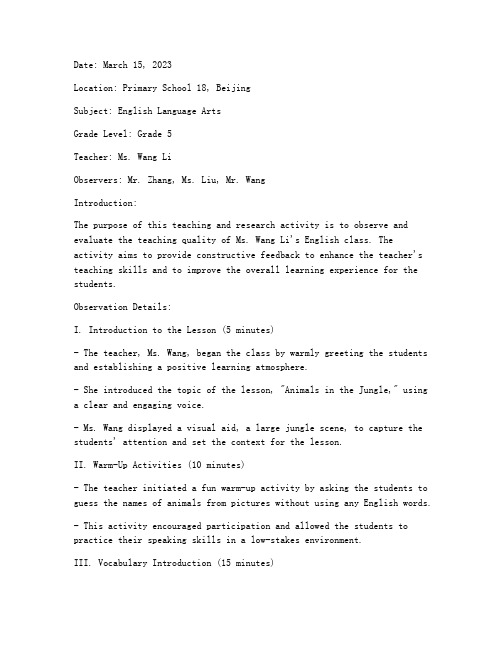
Date: March 15, 2023Location: Primary School 18, BeijingSubject: English Language ArtsGrade Level: Grade 5Teacher: Ms. Wang LiObservers: Mr. Zhang, Ms. Liu, Mr. WangIntroduction:The purpose of this teaching and research activity is to observe and evaluate the teaching quality of Ms. Wang Li's English class. Theactivity aims to provide constructive feedback to enhance the teacher's teaching skills and to improve the overall learning experience for the students.Observation Details:I. Introduction to the Lesson (5 minutes)- The teacher, Ms. Wang, began the class by warmly greeting the students and establishing a positive learning atmosphere.- She introduced the topic of the lesson, "Animals in the Jungle," using a clear and engaging voice.- Ms. Wang displayed a visual aid, a large jungle scene, to capture the students' attention and set the context for the lesson.II. Warm-Up Activities (10 minutes)- The teacher initiated a fun warm-up activity by asking the students to guess the names of animals from pictures without using any English words.- This activity encouraged participation and allowed the students to practice their speaking skills in a low-stakes environment.III. Vocabulary Introduction (15 minutes)- Ms. Wang introduced new vocabulary words related to the jungle, such as "gorilla," "elephant," "tiger," and "jungle."- She used a variety of teaching aids, including flashcards and a whiteboard, to display the words and their meanings.- The teacher demonstrated the pronunciation of each word and provided examples of how the words could be used in a sentence.IV. Reading Comprehension (20 minutes)- Ms. Wang distributed a short reading passage about different animals in the jungle.- She guided the students through the reading process by asking questions and prompting them to think critically about the text.- The teacher encouraged students to predict the content of the passage and to summarize the main ideas.V. Grammar Practice (15 minutes)- Ms. Wang introduced a new grammar concept: present continuous tense.- She demonstrated the structure using examples and had students practice forming sentences using the new tense.- The teacher used a worksheet to provide structured practice, ensuring that students could apply the grammar concept independently.VI. Group Work (15 minutes)- The class was divided into small groups, and each group was given a task to create a poster about their favorite animal in the jungle.- The teacher provided guidelines and allowed students to work collaboratively, fostering teamwork and communication skills.VII. Presentation and Feedback (10 minutes)- Each group presented their poster to the class, and the teacher encouraged the students to ask questions and provide feedback.- Ms. Wang provided positive feedback and constructive criticism, emphasizing the students' efforts and achievements.VIII. Conclusion and Homework Assignment (5 minutes)- Ms. Wang summarized the key points of the lesson and reminded students of the homework assignment: to write a short paragraph about their favorite animal in the jungle using the present continuous tense.Feedback and Recommendations:Strengths:- Ms. Wang demonstrated excellent classroom management skills, maintaining a positive and engaging learning environment.- She effectively utilized a variety of teaching aids and techniques to cater to different learning styles.- The teacher encouraged active participation and provided opportunities for students to practice their speaking and listening skills.- Ms. Wang provided clear and structured feedback, which helped students to understand their strengths and areas for improvement.Areas for Improvement:- The teacher could allocate more time for individual practice during the grammar section to ensure that all students have a chance to master the new concept.- It would be beneficial to include more interactive activities that require students to work in pairs or small groups, promoting collaborative learning.- The teacher could incorporate more authentic materials, such as real-life videos or audio recordings, to enhance the relevance and interest of the lesson.Conclusion:Ms. Wang Li's English class was a well-structured and engaging lesson that effectively catered to the needs of the students. The teacher demonstrated a strong command of the subject matter and possessed excellent pedagogical skills. With a few minor adjustments, the teaching quality can be further improved, leading to enhanced learning outcomes for the students.。
初中英语教研评课(3篇)
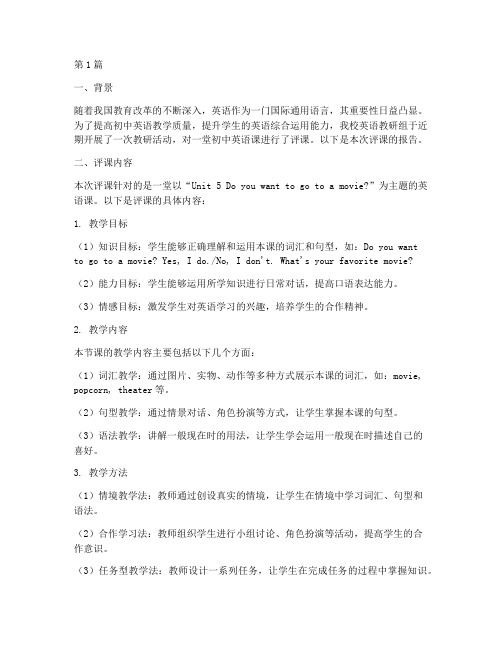
第1篇一、背景随着我国教育改革的不断深入,英语作为一门国际通用语言,其重要性日益凸显。
为了提高初中英语教学质量,提升学生的英语综合运用能力,我校英语教研组于近期开展了一次教研活动,对一堂初中英语课进行了评课。
以下是本次评课的报告。
二、评课内容本次评课针对的是一堂以“Unit 5 Do you want to go to a movie?”为主题的英语课。
以下是评课的具体内容:1. 教学目标(1)知识目标:学生能够正确理解和运用本课的词汇和句型,如:Do you wantto go to a movie? Yes, I do./No, I don't. What's your favorite movie?(2)能力目标:学生能够运用所学知识进行日常对话,提高口语表达能力。
(3)情感目标:激发学生对英语学习的兴趣,培养学生的合作精神。
2. 教学内容本节课的教学内容主要包括以下几个方面:(1)词汇教学:通过图片、实物、动作等多种方式展示本课的词汇,如:movie, popcorn, theater等。
(2)句型教学:通过情景对话、角色扮演等方式,让学生掌握本课的句型。
(3)语法教学:讲解一般现在时的用法,让学生学会运用一般现在时描述自己的喜好。
3. 教学方法(1)情境教学法:教师通过创设真实的情境,让学生在情境中学习词汇、句型和语法。
(2)合作学习法:教师组织学生进行小组讨论、角色扮演等活动,提高学生的合作意识。
(3)任务型教学法:教师设计一系列任务,让学生在完成任务的过程中掌握知识。
4. 教学过程(1)导入:教师通过提问的方式导入新课,激发学生的学习兴趣。
(2)新授:教师讲解本课的词汇、句型和语法,并通过多种方式让学生掌握。
(3)巩固:教师组织学生进行练习,巩固所学知识。
(4)拓展:教师设计一些拓展活动,让学生在课外继续学习。
(5)总结:教师对本节课的内容进行总结,强调重点和难点。
英语教研活动记录_评课

Date: March 15, 2023Location: Primary School No. 5, HefeiParticipants: All English teachers from the school, Headmaster, and District Education Bureau InspectorObjective: To enhance the quality of English teaching through classroom observation, discussion, and feedback.Introduction:The English教研活动 (English Teaching and Research Activity) was organized to provide a platform for teachers to observe and discusstheir peers' teaching methods and strategies. The aim was to promote continuous professional development and to foster a collaborative environment among the faculty.I. Classroom Observation:The observation focused on a Grade 5 English lesson taught by Ms. Wang. The lesson was designed to introduce the topic of "Family Members" and to practice the use of simple present tense. The classroom was equipped with multimedia tools, including an interactive whiteboard, projectors, and a computer.II. Detailed Observation Notes:1. Warm-up Activity:- Ms. Wang started the lesson with a fun and engaging warm-up activity. She used a song about family members to create a positive and interactive learning environment.- Students actively participated in the singing, which helped them to relax and prepare for the main lesson.2. Introduction of New Vocabulary:- Ms. Wang introduced new vocabulary items such as "brother," "sister," "uncle," "aunt," and "cousin" through real-life examples and pictures.- She used a variety of teaching aids, including flashcards and handouts, to reinforce the learning.3. Grammar Focus:- The lesson focused on the simple present tense. Ms. Wang demonstrated the structure and usage through clear and concise explanations.- She provided examples of sentences and encouraged students to practice by forming their own sentences.4. Interactive Activities:- Ms. Wang incorporated various interactive activities to keep the students engaged. She used group work, pair work, and individual tasks.- One activity involved students creating a family tree on the interactive whiteboard, which they could label with the new vocabulary.5. Assessment and Feedback:- Ms. Wang regularly checked for understanding through formative assessments, such as asking questions and checking students' work.- She provided immediate feedback, which helped students to correct their mistakes and improve their language skills.6. Conclusion and Homework:- The lesson concluded with a summary of the new vocabulary and grammar points.- Ms. Wang assigned homework that required students to describe their own families using the new vocabulary and tense.III. Review and Discussion:After the observation, the teachers gathered for a review and discussion session. The following points were highlighted:1. Positive Aspects:- The warm-up activity was well-received by the students and set a positive tone for the lesson.- Ms. Wang's explanations were clear and easy to understand.- The use of multimedia tools enhanced the learning experience.2. Areas for Improvement:- Some teachers suggested that Ms. Wang could provide more opportunities for students to practice speaking in English, as the lesson seemed to be more focused on reading and writing.- The assessment methods could be diversified to include more oral assessments.3. Suggestions for Future Lessons:- Incorporate more interactive games and role-plays to improve speaking skills.- Use more authentic materials, such as videos and songs, to engage students.- Provide more individualized feedback to cater to different learning styles.IV. Conclusion:The English教研活动 provided a valuable opportunity for teachers to observe and learn from each other. The classroom observation of Ms. Wang's lesson highlighted the importance of engaging activities, clear explanations, and formative assessments. The feedback and suggestions shared during the review session will undoubtedly contribute to the improvement of English teaching practices at our school.Participants' Signatures:[Headmaster][District Education Bureau Inspector][English Department Head] [Ms. Wang][Other English Teachers] Date: March 15, 2023。
初中英语听评课教研记录(3篇)

第1篇一、教研活动背景随着新课程改革的不断深入,初中英语教学也面临着新的挑战和机遇。
为了提高英语教师的教学水平,促进教师的专业成长,我校英语教研组于2021年10月15日开展了听评课教研活动。
本次教研活动旨在通过观摩优秀教师的课堂,交流教学经验,探讨教学方法,提升教师的教学能力。
二、教研活动过程1. 观摩优秀教师的课堂本次教研活动邀请了我校英语教研组长李老师进行公开课展示。
李老师讲授的是七年级英语上册的《Unit 3 My School Life》一课。
李老师以生动有趣的教学方式,将课堂氛围调动得非常活跃。
她运用多媒体课件,通过图片、视频等多种形式,让学生在轻松愉快的氛围中学习英语。
在课堂上,李老师注重培养学生的听说读写能力,让学生在实践中运用所学知识。
2. 教师评课课后,全体英语教师对李老师的课堂进行了评课。
首先,大家一致认为李老师的课堂设计合理,教学方法灵活多样,课堂氛围活跃,能够充分调动学生的学习积极性。
其次,老师们针对李老师的课堂进行了以下评价:(1)课堂导入环节,李老师运用图片和视频,激发了学生的学习兴趣,使学生对本节课的内容有了初步的了解。
(2)在词汇教学环节,李老师通过创设情境,让学生在具体的语境中学习单词,提高了学生的词汇运用能力。
(3)在句型教学环节,李老师注重培养学生的口语表达能力,让学生在课堂上进行角色扮演,提高了学生的口语交际能力。
(4)课堂练习环节,李老师设计了多种形式的练习,使学生在巩固知识的同时,提高了课堂参与度。
3. 交流教学经验在评课的基础上,老师们就如何提高英语教学质量进行了交流。
以下是部分老师的发言:(1)张老师:在英语教学中,我们要注重培养学生的听说读写能力,让学生在实践中运用所学知识。
(2)王老师:课堂导入环节非常重要,我们要运用多种形式激发学生的学习兴趣。
(3)刘老师:在词汇教学环节,我们要注重语境的创设,让学生在具体的语境中学习单词。
(4)李老师:课堂练习环节要多样化,提高学生的课堂参与度。
英语组教研活动评课记录

活动时间:2023年3月15日活动地点:学校英语组办公室参与人员:英语组全体教师活动主题:基于核心素养的英语课堂设计与实施主持人:张老师一、活动背景为了提升英语教学质量,加强教师之间的交流与合作,英语组决定开展一次教研活动,以评课的形式对近期的一节英语课进行深入分析和讨论。
本次活动旨在通过集体智慧,共同探讨如何在课堂中更好地培养学生的核心素养。
二、活动流程1. 课堂教学展示:由李老师执教六年级英语《Unit 3 My weekend plan》一课。
2. 评课环节:各教师就课堂设计、教学方法、学生参与度等方面进行评析。
3. 总结与反思:主持人对本次活动进行总结,并对今后的教学工作提出建议。
三、课堂教学展示李老师以“我的周末计划”为主题,通过图片、视频等多种教学手段,引导学生进行口语表达和写作练习。
课堂气氛活跃,学生参与度高。
四、评课环节1. 张老师:- 优点:李老师的教学设计合理,课堂环节紧凑,教学目标明确。
- 建议:在课堂活动中,可以适当增加一些小组合作学习,让学生在互动中提高英语表达能力。
2. 王老师:- 优点:李老师的课堂氛围良好,学生积极性高,课堂互动性强。
- 建议:在课堂教学中,可以更多地关注学生的个体差异,针对不同层次的学生进行分层教学。
3. 刘老师:- 优点:李老师的课堂导入环节设计巧妙,激发了学生的学习兴趣。
- 建议:在课堂教学中,可以适当增加一些拓展活动,拓宽学生的知识面。
4. 陈老师:- 优点:李老师的课堂板书清晰,重点突出,有助于学生掌握课堂知识。
- 建议:在课堂教学中,可以更多地关注学生的情感态度,培养学生的英语学习兴趣。
五、总结与反思主持人张老师对本次活动进行了总结,并对今后的教学工作提出以下建议:1. 教师要充分认识到核心素养在英语教学中的重要性,将核心素养融入课堂教学中。
2. 教师要注重培养学生的英语听说读写能力,提高学生的综合语言运用能力。
3. 教师要关注学生的个体差异,实施分层教学,让每个学生都能在课堂上有所收获。
高一英语教研活动评课(3篇)

第1篇一、活动背景为了提高高一英语教学质量,促进教师专业成长,我校英语教研组于2023年10月27日组织了一次高一英语教研活动。
本次活动以“课堂观察与教学反思”为主题,旨在通过观摩优秀教师授课,促进教师间的交流与合作,共同探讨提高英语教学效果的方法。
二、活动内容1. 课堂观摩:本次活动邀请了高一英语组优秀教师张老师进行公开课展示。
张老师执教的是人教版高一英语Unit 4 Shopping的第一课时。
课堂上,张老师以“Shopping”为主题,通过图片、视频、歌曲等多种教学手段,激发学生的学习兴趣,引导学生积极参与课堂活动。
2. 评课环节:课后,教研组成员对张老师的课堂教学进行了评课。
首先,大家肯定了张老师的教学优点,如教学目标明确、教学设计合理、教学方法多样、课堂气氛活跃等。
同时,针对课堂教学中存在的问题,大家也提出了中肯的建议。
三、评课内容1. 教学目标明确:张老师在教学设计中,将教学目标设定为:学生能够掌握“Shopping”相关词汇和句型;能够运用所学知识进行简单的购物对话;培养学生良好的购物习惯。
2. 教学设计合理:张老师的教学设计环环相扣,层层递进。
从导入环节的图片展示,到新授环节的词汇和句型教学,再到巩固环节的对话练习,每个环节都紧密相连,使学生能够更好地掌握所学知识。
3. 教学方法多样:张老师采用了多种教学方法,如直观教学法、情景教学法、任务型教学法等。
通过图片、视频、歌曲等多种教学手段,激发了学生的学习兴趣,提高了课堂效率。
4. 课堂气氛活跃:张老师善于调动学生的积极性,鼓励学生大胆发言,积极参与课堂活动。
课堂上,学生们的学习热情高涨,课堂气氛活跃。
5. 存在的问题及建议:(1)课堂提问不够深入:张老师在课堂上主要采用封闭式提问,学生回答问题的机会较少。
建议教师在课堂提问时,尽量采用开放式提问,引导学生进行深入思考。
(2)课堂评价不够具体:张老师在课堂评价方面,主要关注学生的语言输出,而对学生的情感态度、学习习惯等方面的评价较少。
英语教研活动听评课记录
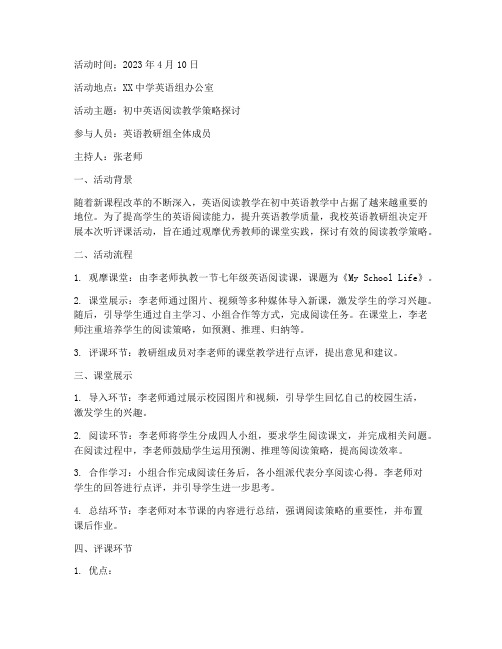
活动时间:2023年4月10日活动地点:XX中学英语组办公室活动主题:初中英语阅读教学策略探讨参与人员:英语教研组全体成员主持人:张老师一、活动背景随着新课程改革的不断深入,英语阅读教学在初中英语教学中占据了越来越重要的地位。
为了提高学生的英语阅读能力,提升英语教学质量,我校英语教研组决定开展本次听评课活动,旨在通过观摩优秀教师的课堂实践,探讨有效的阅读教学策略。
二、活动流程1. 观摩课堂:由李老师执教一节七年级英语阅读课,课题为《My School Life》。
2. 课堂展示:李老师通过图片、视频等多种媒体导入新课,激发学生的学习兴趣。
随后,引导学生通过自主学习、小组合作等方式,完成阅读任务。
在课堂上,李老师注重培养学生的阅读策略,如预测、推理、归纳等。
3. 评课环节:教研组成员对李老师的课堂教学进行点评,提出意见和建议。
三、课堂展示1. 导入环节:李老师通过展示校园图片和视频,引导学生回忆自己的校园生活,激发学生的兴趣。
2. 阅读环节:李老师将学生分成四人小组,要求学生阅读课文,并完成相关问题。
在阅读过程中,李老师鼓励学生运用预测、推理等阅读策略,提高阅读效率。
3. 合作学习:小组合作完成阅读任务后,各小组派代表分享阅读心得。
李老师对学生的回答进行点评,并引导学生进一步思考。
4. 总结环节:李老师对本节课的内容进行总结,强调阅读策略的重要性,并布置课后作业。
四、评课环节1. 优点:- 李老师课堂氛围活跃,激发了学生的学习兴趣。
- 注重培养学生的阅读策略,提高学生的阅读能力。
- 教学环节设计合理,教学目标明确。
- 课堂评价及时、准确,有助于学生巩固所学知识。
2. 不足:- 部分学生参与度不高,课堂互动性有待提高。
- 阅读任务难度适中,但可以适当增加挑战性,提高学生的思维能力。
- 课堂时间分配不够合理,部分环节可以适当缩短。
五、讨论与总结1. 讨论:- 如何提高学生的阅读兴趣?- 如何在阅读教学中培养学生的阅读策略?- 如何在课堂中提高学生的参与度?2. 总结:- 本次听评课活动取得了圆满成功,为英语教研组提供了宝贵的经验。
英语评课教研记录过程(3篇)

第1篇Date: [Insert Date]Subject: English Language ArtsGrade Level: [Insert Grade Level]Teacher: [Insert Teacher's Name]School: [Insert School Name]Objective of the Session:The purpose of this教研记录 session is to evaluate the effectiveness of the English language arts lesson conducted by [Teacher's Name]. The focus is on assessing the lesson's alignment with curriculum objectives, the teacher's instructional strategies, student engagement, and the overall learning outcomes.Introduction:[Teacher's Name] conducted a lesson on [insert topic/genre] in English language arts for [insert grade level]. The lesson was designed to enhance students' reading comprehension, vocabulary, and critical thinking skills. The objective was to help students understand the underlying themes and analyze the characters in the selected text.Lesson Overview:The lesson began with a brief introduction to the text, including a background on the author and the historical context. [Teacher's Name] then engaged the students with a series of warm-up activities designed to activate prior knowledge and build anticipation for the main content.Detailed Evaluation:1. Lesson Preparation:[Teacher's Name] demonstrated thorough preparation for the lesson. The materials were well-organized, and the resources used were appropriatefor the grade level and the topic. The handouts and visual aids were clear and visually engaging.2. Alignment with Curriculum Objectives:The lesson effectively aligned with the state curriculum standards for English language arts. The objectives were clearly stated, and the activities were designed to address the required skills and knowledge.3. Instructional Strategies:[Teacher's Name] employed a variety of instructional strategies to cater to different learning styles. The following are some notable strategies used:- Whole Class Discussion: [Teacher's Name] initiated discussions to explore the themes and characters in the text. This encouraged active participation and critical thinking.- Group Work: Students were divided into small groups to analyzespecific sections of the text, fostering collaboration and peer learning.- Interactive Activities: The use of interactive whiteboards and multimedia presentations kept students engaged and facilitated a dynamic learning environment.- Direct Instruction: [Teacher's Name] provided clear explanations and modeled the analytical process for students, ensuring they understood the concepts.4. Student Engagement:The level of student engagement was high throughout the lesson. Students were actively participating in discussions, contributing their thoughts and questions. The interactive nature of the activities encouraged students to think critically and express their ideas.5. Learning Outcomes:The learning outcomes were evident in the students' responses and participation. By the end of the lesson, students demonstrated anunderstanding of the text's themes and were able to analyze characters and their motivations. The use of exit tickets at the end of the lesson provided valuable feedback on the students' comprehension.Areas for Improvement:- Diverse Assessment Methods: While the lesson was engaging, there could be more diverse methods of assessment to cater to different learning styles and abilities. Incorporating quizzes, reflective writing assignments, or oral presentations could provide a more comprehensive evaluation of student learning.- Differentiation: To further enhance student engagement, [Teacher's Name] could consider differentiating the lesson for students with varying proficiency levels. This could involve providing additional support or extending the activities for advanced learners.- Follow-Up Activities: Post-lesson, [Teacher's Name] could designfollow-up activities that build upon the knowledge gained during the lesson. This would help reinforce the learning and provide students with opportunities to apply their skills in new contexts.Conclusion:Overall, [Teacher's Name]'s English language arts lesson was successful in achieving its objectives. The teacher demonstrated a clear understanding of the curriculum standards and effectively engaged students in a variety of learning activities. The use of diverse instructional strategies and the high level of student engagement were commendable. With a few adjustments in assessment methods and differentiation, the lesson could be further improved to cater to a wider range of students.Recommendations:- Continue to employ a variety of instructional strategies to cater to different learning styles.- Explore diverse assessment methods to provide a comprehensive evaluation of student learning.- Consider differentiating the lesson to meet the needs of students with varying proficiency levels.- Design follow-up activities to reinforce learning and provide students with additional practice opportunities.Signatures:[Teacher's Name][Teacher's Name's Supervisor][School Administrator]第2篇Date: [Insert Date]Subject: English Language ArtsGrade Level: [Insert Grade Level]Teacher: [Insert Teacher's Name]Classroom: [Insert Classroom Number]Duration: [Insert Duration of the Lesson]Introduction:The purpose of this教研记录 is to evaluate the effectiveness of the English language arts lesson conducted by [Teacher's Name] and to discuss strategies for improvement. The lesson focused on [insert main objective or theme of the lesson]. This record will detail the lesson's structure, student engagement, and teacher effectiveness, followed by a reflection and suggestions for future lessons.Lesson Overview:[Teacher's Name] began the lesson with a brief review of [previous lesson's topic or vocabulary], ensuring that students were familiar with the foundational concepts. The main objective of the lesson was to[state the main objective, e.g., improve reading comprehension skills or introduce new grammar structures].Lesson Structure:1. Introduction (5 minutes):- The teacher introduced the new topic by showing a related video or using a visual aid to capture students' interest.- Key vocabulary and concepts were discussed, and students were encouraged to ask questions.2. Direct Instruction (10 minutes):- The teacher presented new information using a PowerPoint or whiteboard, explaining key points and providing examples.- Students took notes and engaged in interactive activities to reinforce understanding.3. Group Work (15 minutes):- Students were divided into small groups to work on a collaborative activity related to the lesson's objective. This involved reading a passage, discussing key points, and creating a summary.- The teacher circulated to provide guidance and answer questions.4. Whole Class Discussion (10 minutes):- Groups presented their summaries, and the class engaged in a discussion to compare and contrast different viewpoints.- The teacher facilitated the discussion, encouraging all students to participate.5. Independent Practice (10 minutes):- Students were given a short reading passage and asked to answer comprehension questions.- The teacher provided feedback and clarification as needed.6. Closing (5 minutes):- The teacher summarized the main points of the lesson and reminded students of the homework assignment.- Students were encouraged to ask any remaining questions.Student Engagement:- Positive: Students appeared engaged throughout the lesson, with most participating actively in discussions and activities. The use of group work and interactive activities seemed to encourage collaboration and participation.- Negative: A few students appeared to be disengaged, possibly due to the complexity of the material or lack of interest in the topic.Teacher Effectiveness:- Positive: The teacher demonstrated good knowledge of the subject matter and was able to provide clear explanations. The use of varied teaching methods kept the lesson interesting and catered to different learning styles.- Negative: The teacher may have spoken too quickly at times, making it difficult for some students to keep up. Additionally, the transition between activities could have been smoother to maintain momentum.Reflection:The lesson was generally successful in achieving its objectives. The use of group work and collaborative activities was particularly effective in promoting student engagement and deeper understanding. However, there were areas that could be improved upon.Suggestions for Future Lessons:1. Pacing: Ensure that the pace of the lesson is manageable, allowing time for students to absorb information and ask questions.2. Differentiation: Provide additional support or challenge for students with varying abilities to ensure that all students can succeed.3. Feedback: Offer more immediate feedback during group work to guide students and correct misconceptions.4. Transition: Plan for smoother transitions between activities to maintain student interest and engagement.5. Technology: Explore the use of educational technology to enhance lesson delivery and provide additional resources for students.Conclusion:This教研记录 has provided valuable insights into the effectiveness of the English language arts lesson. By addressing the identified areas for improvement, [Teacher's Name] can enhance the learning experience forall students. The suggestions offered here are intended to support ongoing professional development and contribute to the overall improvement of teaching and learning in the classroom.第3篇Date: [Date]Subject: [Subject]Teacher: [Teacher's Name]Attendees: [List of Attendees]I. IntroductionThe purpose of this teaching research and evaluation record is to document the process of a lesson conducted by [Teacher's Name] in [Subject] class. This record aims to analyze the effectiveness of the lesson, identify areas for improvement, and provide valuable insightsfor future teaching practices.II. Lesson OverviewA. Lesson Title: [Lesson Title]B. Lesson Duration: [Duration]C. Lesson Objectives:1. [Objective 1]2. [Objective 2]3. [Objective 3]III. Lesson DeliveryA. Introduction:[Teacher's Name] began the lesson by introducing the topic and its relevance to the students. They engaged the class by asking thought-provoking questions and sharing interesting facts.B. Instructional Strategies:1. Direct Instruction: [Teacher's Name] used a clear and concise language to explain the key concepts of the lesson. They provided examples and demonstrated the procedures step by step.2. Guided Practice: Students were given opportunities to practice the concepts through guided activities, such as worksheets and interactive discussions.3. Independent Practice: Students were assigned individual tasks to apply the newly acquired knowledge, promoting active learning andcritical thinking.4. Collaborative Learning: Group activities were designed to encourage students to work together, share ideas, and solve problems collectively.C. Assessment:[Teacher's Name] utilized various assessment methods to evaluate student understanding and progress:1. Formative Assessment: Quick quizzes and class discussions were used to monitor student understanding and provide immediate feedback.2. Summative Assessment: A comprehensive test or assignment was given at the end of the lesson to assess students' overall understanding of the topic.IV. Evaluation and ReflectionA. Student Engagement:- [Positive Aspect]: Students were actively participating in the lesson, asking questions, and contributing to discussions.- [Area for Improvement]: Some students seemed less engaged, possibly due to the complexity of the material or lack of prior knowledge.B. Instructional Delivery:- [Positive Aspect]: [Teacher's Name] presented the material in a clear and organized manner, making it easy for students to follow.- [Area for Improvement]: [Teacher's Name] could have provided more visual aids or real-life examples to enhance understanding.C. Assessment:- [Positive Aspect]: The variety of assessment methods helped to gauge student understanding from different perspectives.- [Area for Improvement]: Providing more detailed feedback on individual student performance would be beneficial for their progress.V. Recommendations for Future LessonsA. Addressing Student Engagement:- Incorporate more interactive and hands-on activities to cater to different learning styles.- Create a positive and inclusive classroom environment to encourage participation from all students.B. Enhancing Instructional Delivery:- Utilize visual aids, such as diagrams or videos, to illustrate complex concepts.- Provide real-life examples or case studies to make the material more relatable and engaging.C. Improving Assessment:- Offer more detailed feedback on student performance, highlighting strengths and areas for improvement.- Consider using a mix of formative and summative assessments to provide a comprehensive evaluation of student learning.VI. ConclusionIn conclusion, the lesson conducted by [Teacher's Name] in [Subject] class was generally effective in achieving the lesson objectives. The teacher demonstrated a clear understanding of the subject matter and employed various instructional strategies to engage the students. However, there are areas for improvement in terms of student engagement, instructional delivery, and assessment. By implementing the recommended changes, [Teacher's Name] can enhance the learning experience for their students and foster a more effective teaching and learning environment.。
英语组教研活动评课记录(3篇)

第1篇一、活动背景为了提高英语组教师的教学水平,加强教师之间的交流与合作,我校英语组于2022年10月18日开展了教研活动。
本次活动以评课为主题,旨在通过观摩、研讨、反思,提升教师的教学能力。
本次活动邀请了校领导、其他学科教师及英语组全体教师参加。
二、活动内容1. 观摩课本次活动由英语组青年教师李老师主讲,课题为《Unit 5 If you go to the party》。
李老师以生动有趣的教学方法,引导学生积极参与课堂活动,课堂气氛活跃。
以下是李老师课堂的主要环节:(1)导入:通过播放一首与课文内容相关的歌曲,激发学生的学习兴趣。
(2)新课呈现:通过图片、视频等多媒体手段,展示课文内容,让学生直观地了解课文。
(3)词汇教学:针对课文中的重点词汇,进行讲解和练习。
(4)语法教学:针对课文中的重点语法,进行讲解和练习。
(5)课文朗读:让学生跟读课文,提高学生的语音、语调。
(6)课堂小结:回顾本节课所学内容,布置课后作业。
2. 评课环节在观摩课后,英语组全体教师对李老师的课堂教学进行了评课。
以下是评课的主要内容:(1)优点:1. 教学目标明确,教学重点突出。
2. 教学方法多样,课堂气氛活跃。
3. 教学内容丰富,注重培养学生的综合语言运用能力。
4. 课堂评价及时,关注学生的个体差异。
(2)不足:1. 部分环节时间分配不合理,如词汇教学环节时间过长。
2. 部分学生参与度不高,课堂互动性有待提高。
3. 课后作业布置过于简单,未能充分调动学生的学习积极性。
三、活动总结1. 通过本次教研活动,英语组教师对课堂教学有了更深入的认识,提高了自身的教学水平。
2. 活动中,教师们积极参与评课,提出了许多有针对性的意见和建议,有助于李老师改进教学。
3. 活动充分展示了英语组教师团结协作、共同进步的精神风貌。
四、改进措施1. 教师应合理安排课堂时间,确保教学环节的完整性。
2. 注重学生的个体差异,提高课堂互动性,激发学生的学习兴趣。
初中英语教研评课记录(3篇)
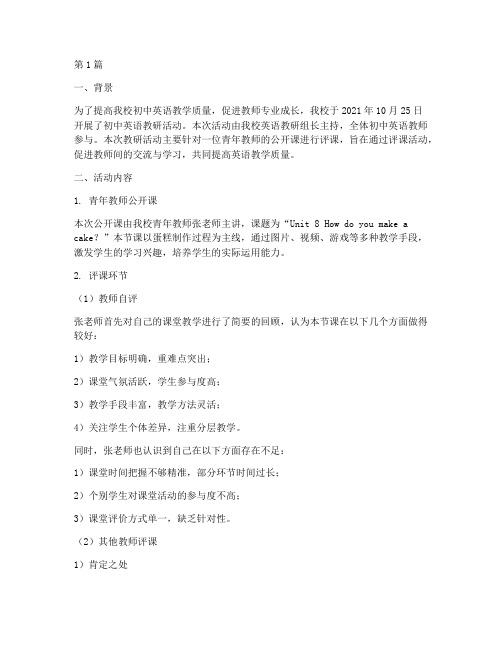
第1篇一、背景为了提高我校初中英语教学质量,促进教师专业成长,我校于2021年10月25日开展了初中英语教研活动。
本次活动由我校英语教研组长主持,全体初中英语教师参与。
本次教研活动主要针对一位青年教师的公开课进行评课,旨在通过评课活动,促进教师间的交流与学习,共同提高英语教学质量。
二、活动内容1. 青年教师公开课本次公开课由我校青年教师张老师主讲,课题为“Unit 8 How do you make a cake?”本节课以蛋糕制作过程为主线,通过图片、视频、游戏等多种教学手段,激发学生的学习兴趣,培养学生的实际运用能力。
2. 评课环节(1)教师自评张老师首先对自己的课堂教学进行了简要的回顾,认为本节课在以下几个方面做得较好:1)教学目标明确,重难点突出;2)课堂气氛活跃,学生参与度高;3)教学手段丰富,教学方法灵活;4)关注学生个体差异,注重分层教学。
同时,张老师也认识到自己在以下方面存在不足:1)课堂时间把握不够精准,部分环节时间过长;2)个别学生对课堂活动的参与度不高;3)课堂评价方式单一,缺乏针对性。
(2)其他教师评课1)肯定之处①教学目标明确,重难点突出。
张老师能够根据学生的实际情况,制定合理的教学目标,并在课堂教学中注重对学生重难点的突破。
②教学手段丰富,教学方法灵活。
张老师善于运用图片、视频、游戏等多种教学手段,激发学生的学习兴趣,提高课堂效率。
③关注学生个体差异,注重分层教学。
张老师在课堂教学中关注学生的个体差异,针对不同层次的学生进行分层教学,使每个学生都能在课堂上有所收获。
2)改进之处①课堂时间把握不够精准。
建议张老师在教学过程中,对课堂时间进行更合理的分配,确保每个环节都能在规定时间内完成。
②个别学生对课堂活动的参与度不高。
建议张老师在教学过程中,多关注学生的个体需求,鼓励学生积极参与课堂活动。
③课堂评价方式单一,缺乏针对性。
建议张老师根据学生的学习情况,采用多元化的评价方式,使评价更具针对性。
英语课评课教研活动记录
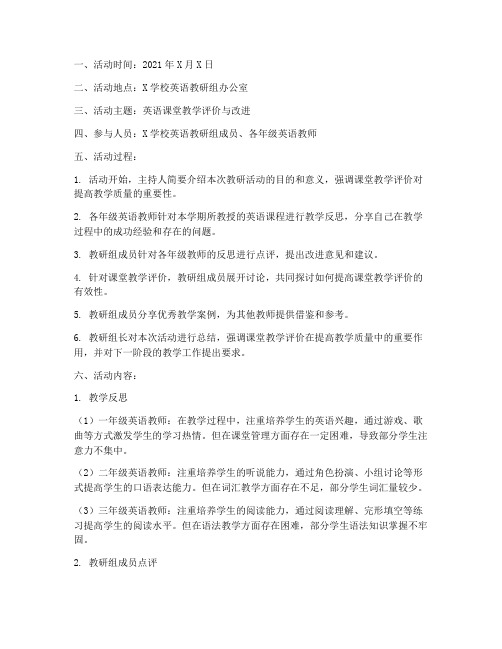
一、活动时间:2021年X月X日二、活动地点:X学校英语教研组办公室三、活动主题:英语课堂教学评价与改进四、参与人员:X学校英语教研组成员、各年级英语教师五、活动过程:1. 活动开始,主持人简要介绍本次教研活动的目的和意义,强调课堂教学评价对提高教学质量的重要性。
2. 各年级英语教师针对本学期所教授的英语课程进行教学反思,分享自己在教学过程中的成功经验和存在的问题。
3. 教研组成员针对各年级教师的反思进行点评,提出改进意见和建议。
4. 针对课堂教学评价,教研组成员展开讨论,共同探讨如何提高课堂教学评价的有效性。
5. 教研组成员分享优秀教学案例,为其他教师提供借鉴和参考。
6. 教研组长对本次活动进行总结,强调课堂教学评价在提高教学质量中的重要作用,并对下一阶段的教学工作提出要求。
六、活动内容:1. 教学反思(1)一年级英语教师:在教学过程中,注重培养学生的英语兴趣,通过游戏、歌曲等方式激发学生的学习热情。
但在课堂管理方面存在一定困难,导致部分学生注意力不集中。
(2)二年级英语教师:注重培养学生的听说能力,通过角色扮演、小组讨论等形式提高学生的口语表达能力。
但在词汇教学方面存在不足,部分学生词汇量较少。
(3)三年级英语教师:注重培养学生的阅读能力,通过阅读理解、完形填空等练习提高学生的阅读水平。
但在语法教学方面存在困难,部分学生语法知识掌握不牢固。
2. 教研组成员点评(1)一年级英语教师:在课堂管理方面,建议加强师生互动,关注每个学生的表现,及时发现并纠正学生的不良行为。
(2)二年级英语教师:在词汇教学方面,建议通过图片、故事等生动形象的方式帮助学生记忆单词,提高学生的学习兴趣。
(3)三年级英语教师:在语法教学方面,建议采用分层教学,针对不同层次的学生制定不同的教学计划,确保每个学生都能掌握语法知识。
3. 课堂教学评价(1)评价方式:采用多元化评价方式,包括课堂表现、作业完成情况、考试成绩等。
(2)评价内容:关注学生的英语学习兴趣、学习习惯、听说读写能力等方面。
英语教研评课活动记录
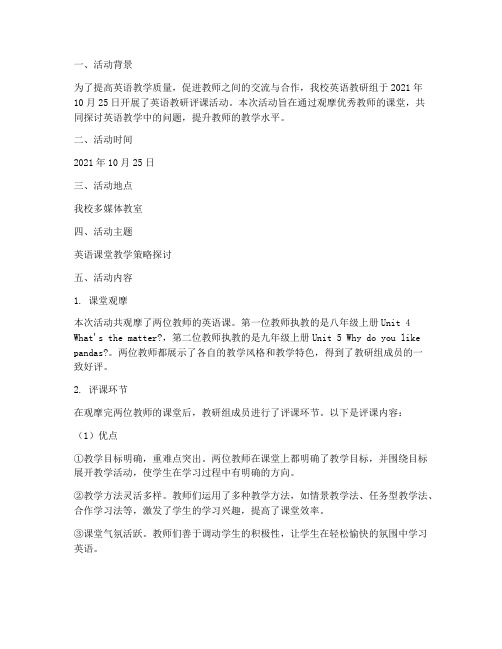
一、活动背景为了提高英语教学质量,促进教师之间的交流与合作,我校英语教研组于2021年10月25日开展了英语教研评课活动。
本次活动旨在通过观摩优秀教师的课堂,共同探讨英语教学中的问题,提升教师的教学水平。
二、活动时间2021年10月25日三、活动地点我校多媒体教室四、活动主题英语课堂教学策略探讨五、活动内容1. 课堂观摩本次活动共观摩了两位教师的英语课。
第一位教师执教的是八年级上册Unit 4 What's the matter?,第二位教师执教的是九年级上册Unit 5 Why do you like pandas?。
两位教师都展示了各自的教学风格和教学特色,得到了教研组成员的一致好评。
2. 评课环节在观摩完两位教师的课堂后,教研组成员进行了评课环节。
以下是评课内容:(1)优点①教学目标明确,重难点突出。
两位教师在课堂上都明确了教学目标,并围绕目标展开教学活动,使学生在学习过程中有明确的方向。
②教学方法灵活多样。
教师们运用了多种教学方法,如情景教学法、任务型教学法、合作学习法等,激发了学生的学习兴趣,提高了课堂效率。
③课堂气氛活跃。
教师们善于调动学生的积极性,让学生在轻松愉快的氛围中学习英语。
④注重培养学生的核心素养。
教师在课堂教学中关注学生的情感态度、价值观等方面的培养,有助于学生全面发展。
(2)不足①课堂时间安排不够合理。
部分教师课堂时间分配不均,导致某些环节过于仓促,影响了教学效果。
②教师与学生互动不足。
部分教师在课堂上过于注重讲解,忽略了与学生之间的互动,使得课堂气氛较为沉闷。
③教学评价方式单一。
部分教师仅通过课堂提问、作业批改等方式进行评价,未能全面了解学生的学习情况。
3. 经验分享在评课环节结束后,教研组成员结合自身教学经验,分享了一些教学心得:(1)注重课堂时间分配,合理安排教学环节。
(2)加强师生互动,提高课堂参与度。
(3)多样化教学评价方式,全面了解学生学习情况。
(4)关注学生情感态度、价值观等方面的培养,促进学生全面发展。
英语教研组活动记录评课(3篇)

第1篇Date: [Insert Date]Location: [Insert Venue]Participants: [List of Participants]Subject: English Language TeachingObjective: To enhance teaching quality and promote collaborative learning among the English教研组 members.---I. IntroductionThe English Research and Teaching Group (教研组) held its monthlyactivity on [Insert Date] at [Insert Venue]. The primary focus of this meeting was to evaluate a lesson delivered by [Teacher's Name], a member of our team. The objective was to provide constructive feedback,identify areas of improvement, and share best practices to enhance the overall teaching quality in our department.---II. Lesson OverviewThe lesson was conducted by [Teacher's Name] for [Grade Level/Class] on the topic of [Lesson Topic]. The lesson aimed to introduce [Main Objective] and covered key vocabulary and grammar structures. The following is a brief outline of the lesson structure:1. Warm-up Activity: [Teacher's Name] started the lesson with a [Brief Description of Warm-up Activity], which aimed to engage students and activate prior knowledge.2. Introduction: The teacher introduced the topic using a [Brief Description of Introduction Technique], ensuring clarity and relevance.3. Vocabulary and Grammar: The teacher presented new vocabulary and grammar points through a combination of [Teaching Method 1] and [Teaching Method 2].4. Practice Activities: Students engaged in various activities to practice the new language, including [Activity 1], [Activity 2], and [Activity 3].5. Reflection and Closure: The teacher concluded the lesson with a [Brief Description of Reflection and Closure Activity], encouraging students to reflect on what they had learned.---III. EvaluationThe following is a detailed evaluation of the lesson based on various criteria:A. Lesson Preparation:- Content Relevance: The lesson content was well-aligned with the curriculum objectives and was relevant to the students' needs.- Materials and Resources: The teacher utilized a variety of resources, including handouts, multimedia presentations, and realia, to enhance student engagement.- Time Management: The teacher effectively managed the time, ensuring that all activities were completed within the allotted time frame.B. Teaching Strategies:- Engagement: The teacher employed various strategies to maintain student engagement, such as interactive games, group work, and real-life examples.- Differentiation: The teacher made efforts to cater to the diverse learning needs of the students, providing additional support and challenging tasks.- Feedback: The teacher provided timely and constructive feedback, both during and after the lesson, to help students improve their language skills.C. Assessment:- Formative Assessment: The teacher used a range of formative assessment techniques, such as questioning, peer feedback, and self-assessment, to monitor student progress.- Summative Assessment: The teacher planned a summative assessment to evaluate students' understanding of the lesson objectives.- Assessment for Learning: The teacher used assessment to inform their teaching, adjusting activities and strategies based on student performance.D. Professionalism:- Punctuality: The teacher arrived on time and was well-prepared for the lesson.- Dress Code: The teacher maintained a professional appearance and demeanor throughout the lesson.- Communication: The teacher communicated effectively with both students and colleagues, ensuring a positive learning environment.---IV. Feedback and RecommendationsPositive Feedback:- The teacher demonstrated excellent subject knowledge and pedagogical skills.- The lesson was well-structured and engaging, with a variety of activities to cater to different learning styles.- The teacher created a positive and supportive learning environment, fostering student participation and collaboration.Areas for Improvement:- The teacher could consider incorporating more varied questioning techniques to encourage deeper thinking and reflection.- Providing explicit instructions for group work and individual tasks could help students stay on track and ensure equal participation.- Incorporating more interactive and collaborative activities, such as role-plays and debates, could further enhance student engagement.Recommendations:- The teacher is encouraged to explore different questioning strategies and provide explicit instructions for group work.- Collaborating with colleagues to share best practices and resources could further enhance teaching quality.- The teacher is recommended to attend professional development workshops to stay updated with the latest teaching methodologies and techniques.---V. ConclusionThe English Research and Teaching Group appreciates the efforts of [Teacher's Name] in delivering a well-prepared and engaging lesson. The feedback provided aims to support the teacher's professional growth and enhance the overall teaching quality in our department. We look forward to continuing our collaborative efforts to provide the best possible learning experience for our students.---End of Record第2篇Date: [Insert Date]Time: [Insert Time]Location: [Insert Location]Participants: [List of Participants]Moderator: [Moderator's Name]Objective: To enhance the quality of English teaching and learning through peer review and feedback on the recent lesson delivery.---I. IntroductionThe English Research and Teaching Group (ERTG) held its monthly activity on [Insert Date], focusing on the review of the recent English lesson delivered by [Teacher's Name]. The objective of this activity was to provide constructive feedback and suggestions to improve the teaching methods and outcomes of the lesson. The session was attended by [number of participants], including [list of participants], who actively participated in the discussion.II. Overview of the LessonThe lesson, which took place on [Insert Date], was centered around the topic of [Insert Topic]. [Teacher's Name] employed various teaching strategies, including [mention specific strategies], to engage the students and facilitate learning. The lesson structure included an introduction, main content delivery, activities, and a conclusion.III. Positive Aspects1. Engagement: The participants appreciated the high level of student engagement during the lesson. [Teacher's Name] effectively used interactive activities and group work to keep the students involved and interested.2. Resource Utilization: The use of multimedia resources, such as videos and interactive whiteboards, was well-received and enhanced the learning experience.3. Cultural Context: [Teacher's Name] successfully integrated cultural elements into the lesson, making it more relatable and interesting for the students.4. Assessment: The inclusion of formative assessments throughout the lesson helped to gauge the students' understanding and provided timely feedback.IV. Areas for Improvement1. Time Management: Some participants felt that the lesson could have been better structured in terms of time management. For instance,certain activities took longer than anticipated, leading to a rushed conclusion.2. Differentiation: While the lesson was engaging, there was a suggestion to further differentiate the activities to cater to the diverse needs and abilities of the students.3. Language Complexity: The use of complex vocabulary and sentence structures was appreciated, but it was suggested that [Teacher's Name] consider the level of the class and adjust the complexity accordingly.4. Feedback Mechanism: The participants recommended the implementation of a more structured feedback mechanism to ensure that students receive constructive criticism and are motivated to improve.V. Discussion and SuggestionsThe group engaged in a lively discussion, offering the following suggestions:1. Time Management: [Teacher's Name] was advised to use timers or clocks to better manage the lesson's flow and allocate time more effectively to each activity.2. Differentiation: The group suggested creating alternative activities or resources for students with varying proficiency levels to ensure that all students can participate and learn effectively.3. Language Complexity: [Teacher's Name] was encouraged to pre-teach new vocabulary and phrases to ensure that students can follow the lesson without confusion.4. Feedback Mechanism: It was proposed to implement a peer-review system where students provide feedback to each other, which can then be used by the teacher to tailor future lessons.VI. ConclusionThe English Research and Teaching Group's class review activity proved to be a valuable opportunity for [Teacher's Name] to receiveconstructive feedback and suggestions for improvement. The group's discussions were insightful and provided a clear path forward for enhancing the quality of teaching and learning in the English classroom. The participants expressed their gratitude to [Teacher's Name] for sharing their lesson and looked forward to future collaborations and learning opportunities.VII. Action Plan1. [Teacher's Name] will review the feedback and incorporate the suggested improvements into their future lessons.2. The ERTG will schedule another class review session in [Insert Future Date] to monitor progress and provide ongoing support.3. The group will explore the possibility of implementing a peer-review system for student feedback.---End of Activity Record[Signatures of Participants][Date of Sign-off]第3篇一、活动背景为了提高英语教学质量,加强教师之间的交流与合作,我校英语教研组于近日开展了评课活动。
初中英语教研听评课记录(3篇)

第1篇一、活动背景为了提高英语教学质量,促进教师专业成长,我校英语教研组于2021年10月26日开展了听评课活动。
本次听评课活动以“提升初中英语课堂教学效果”为主题,旨在通过听课、评课,发现问题,改进教学,提高英语教师的教学水平和学生的英语学习效果。
二、活动内容1. 听课本次听评课活动共安排了两位英语教师进行公开课展示,分别是八年级的《Unit 5 Do you want to watch a movie?》和九年级的《Unit 7 Will people have robots?》。
2. 评课听课结束后,教研组成员对两位教师的课堂教学进行了评课。
评课内容包括教学目标、教学内容、教学方法、教学过程、教学效果等方面。
三、听课记录1. 八年级英语《Unit 5 Do you want to watch a movie?》授课教师:张老师教学内容:本节课主要围绕电影话题展开,通过听、说、读、写等活动,帮助学生掌握电影相关词汇和句型,提高学生的英语交际能力。
教学过程:(1)导入:张老师通过展示电影海报,激发学生的学习兴趣,引出本节课的主题。
(2)新课呈现:通过听录音、看图片、讨论等方式,引导学生学习电影相关词汇和句型。
(3)巩固练习:设计多种形式的练习,如小组合作、角色扮演等,让学生在实际情境中运用所学知识。
(4)小结:总结本节课所学内容,强调重点知识。
教学效果:学生参与度高,课堂气氛活跃,教学目标达成较好。
2. 九年级英语《Unit 7 Will people have robots?》授课教师:李老师教学内容:本节课主要围绕机器人话题展开,通过讨论、辩论等活动,引导学生思考科技发展对人类生活的影响,提高学生的英语思维能力和表达能力。
教学过程:(1)导入:李老师通过展示机器人图片,引出本节课的主题。
(2)新课呈现:通过小组讨论、辩论等方式,引导学生思考机器人对人类生活的影响。
(3)巩固练习:设计情景对话、写作等练习,让学生运用所学知识表达自己的观点。
英语教研评课记录初中(3篇)
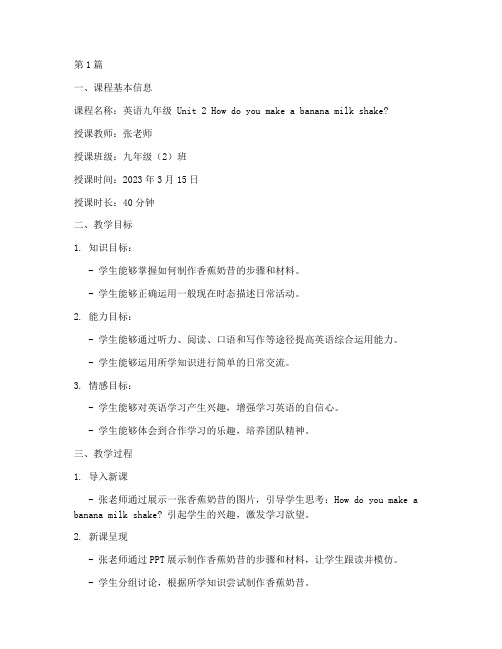
第1篇一、课程基本信息课程名称:英语九年级 Unit 2 How do you make a banana milk shake?授课教师:张老师授课班级:九年级(2)班授课时间:2023年3月15日授课时长:40分钟二、教学目标1. 知识目标:- 学生能够掌握如何制作香蕉奶昔的步骤和材料。
- 学生能够正确运用一般现在时态描述日常活动。
2. 能力目标:- 学生能够通过听力、阅读、口语和写作等途径提高英语综合运用能力。
- 学生能够运用所学知识进行简单的日常交流。
3. 情感目标:- 学生能够对英语学习产生兴趣,增强学习英语的自信心。
- 学生能够体会到合作学习的乐趣,培养团队精神。
三、教学过程1. 导入新课- 张老师通过展示一张香蕉奶昔的图片,引导学生思考:How do you make a banana milk shake? 引起学生的兴趣,激发学习欲望。
2. 新课呈现- 张老师通过PPT展示制作香蕉奶昔的步骤和材料,让学生跟读并模仿。
- 学生分组讨论,根据所学知识尝试制作香蕉奶昔。
3. 听力练习- 张老师播放一段关于制作香蕉奶昔的听力材料,让学生回答问题,巩固所学知识。
- 学生通过小组合作,总结听力材料中的关键信息。
4. 阅读理解- 张老师展示一篇关于制作香蕉奶昔的短文,让学生阅读并回答问题。
- 学生通过小组讨论,分析短文中的语法结构和词汇用法。
5. 口语练习- 张老师组织学生进行角色扮演,模拟制作香蕉奶昔的场景。
- 学生通过口语练习,提高实际运用英语的能力。
6. 写作练习- 张老师布置写作任务,要求学生用英语写一篇关于制作香蕉奶昔的短文。
- 学生独立完成写作任务,张老师进行个别辅导。
7. 总结与反思- 张老师引导学生回顾本节课所学内容,总结制作香蕉奶昔的步骤和材料。
- 学生分享自己的学习心得,提出改进意见。
四、教学效果评价1. 学生参与度高,课堂气氛活跃。
学生在课堂上的表现积极,能够主动参与各项活动,体现了张老师的教学魅力。
教研活动英语评课记录

Date: [Insert Date]Subject: [Insert Subject]Grade Level: [Insert Grade Level]Teacher: [Insert Teacher's Name]Classroom: [Insert Classroom Number]Number of Students: [Insert Number of Students]---Introduction:The purpose of this teaching research activity was to evaluate the effectiveness of the lesson delivered by [Teacher's Name] to [Grade Level] students. The lesson focused on [Insert Main Topic or Objective], and the activity aimed to assess the students' understanding and engagement with the subject matter. This evaluation record will detail the strengths and areas for improvement identified during the lesson.---Observations:1. Lesson Structure and Content Delivery:- Strengths:- The teacher started the lesson with an engaging icebreaker activity that encouraged students to think critically and express their opinions.- The lesson plan was well-structured, with clear objectives and a logical progression of activities.- The teacher effectively utilized a variety of teaching methods, including interactive whiteboard presentations, group discussions, and individual tasks.- The teacher demonstrated a good command of the subject matter and was able to answer questions with confidence.- Areas for Improvement:- The introduction to the main topic could have been more thorough to ensure all students were on the same page.- The pacing of the lesson was slightly fast, which may have left some students struggling to keep up.- The teacher could have provided more explicit instructions for group activities to ensure equal participation.2. Student Engagement and Participation:- Strengths:- The students were generally engaged throughout the lesson, with many actively participating in discussions and activities.- The teacher encouraged student collaboration and created a positive learning environment.- The use of multimedia resources, such as videos and interactive games, kept the students interested.- Areas for Improvement:- Some students appeared to be less engaged, possibly due to the fast pace of the lesson or lack of prior knowledge on the topic.- The teacher could have implemented more varied assessment methods to cater to different learning styles and ensure all students were being challenged.3. Assessment and Feedback:- Strengths:- The teacher provided timely and constructive feedback to students, both during and after the lesson.- The assessment methods used were appropriate for the lesson objectives and provided valuable insights into the students' understanding of the material.- Areas for Improvement:- The teacher could have provided more immediate feedback on group activities to ensure all students were on track.- The assessment methods could be further diversified to include both formative and summative assessments.---Conclusion:Overall, [Teacher's Name] delivered a well-structured and engaging lesson that achieved the intended learning objectives. The use of a variety of teaching methods and resources was commendable, and the teacher's enthusiasm for the subject matter was evident. However, there are areas where the lesson could be improved to enhance student engagement and learning outcomes.Recommendations:1. Thorough Introduction: Spend more time introducing the main topic to ensure all students have a clear understanding of the subject matter.2. Pacing: Adjust the pacing of the lesson to accommodate the needs of all students, particularly those who may be struggling to keep up.3. Explicit Instructions: Provide clearer instructions for group activities to ensure equal participation and prevent off-task behavior.4. Diversified Assessment: Implement a range of assessment methods to cater to different learning styles and provide comprehensive feedback.5. Immediate Feedback: Offer immediate feedback during group activities to keep students on track and address any misconceptions.Additional Notes:- The teacher's use of technology was effective, but there were occasional technical difficulties that could be improved.- The classroom environment was conducive to learning, with students having access to necessary resources and a comfortable space to work.- The teacher demonstrated a strong commitment to student learning and was open to feedback and suggestions for improvement.---This evaluation record will be shared with [Teacher's Name] for their review and consideration. It is hoped that this feedback will contribute to their ongoing professional development and the enhancement of their teaching practice.。
- 1、下载文档前请自行甄别文档内容的完整性,平台不提供额外的编辑、内容补充、找答案等附加服务。
- 2、"仅部分预览"的文档,不可在线预览部分如存在完整性等问题,可反馈申请退款(可完整预览的文档不适用该条件!)。
- 3、如文档侵犯您的权益,请联系客服反馈,我们会尽快为您处理(人工客服工作时间:9:00-18:30)。
英语教研评课记录
授课教师:
授课内容:四年级英语
评课时间:20xx年9月16日
参加人员:全体英语教师
评课记录:
1.备课教案设计符合大纲要求与课堂教学目标,各环节时间把握得当,环节与环节之间紧密相扣。
学生基础扎实,课堂常规训练有素。
学生课前准备充分。
2.利用音像资料进行课程回顾,生动有趣,很大程度地提高学生对之前学过内容的积极性与记忆力;同时通过提问来检查学生是否认真复习了上节课所学的内容。
学生学习效果好。
3.通过学生感兴趣的物体或事件来引入新知识,并合理地使用了道具,不仅使学生应用到所学的句型,同时也很好的复习了上节课所学的单词。
学生在小组内能够互帮互助,同时老师也注重知识和图片的积累、运用。
4.用琅琅上口的歌谣来总结这节课所学的内容及知识结构,让学生记忆深刻,寓娱乐于学习中,学生的学习积极性大大提高,更能使其课后自主学习。
课前预习的比较充分,值得学习。
5.整节课下来,该老师上课教态自然大方,课堂用语得体,善用鼓励的话语来赞许及激励学生,很大程度上激发了学生的参与积
极性,积极投入课堂学习中。
后进生带动的很充分,值得学习。
6.课后布置作业新颖,创新,符合该知识点的知识掌握目标,作业适量。
7.课堂气氛活跃,引入自然。
利用创设情境来激发学生的求知兴趣,既复习了上节课的知识点,也稍稍引出该节课的知识目标,再运用事先准备好的卡片来进入新内容的学习。
8.课堂教学贴近生活,易于学习。
知识点操练充分。
课堂教学环节流畅。
整堂课的设计思路非常清晰,活动扎实有效。
在新课教学中围绕几个单词展开扎实有效的训练,以游戏、图片、歌曲等配合教学,使学生学得很有劲,也很扎实。
9.设计合理,备课充分,环节清晰,涵盖的内容量较大,教学方法很实用。
在教学过程中,不但教给学生知识,还交给学生一定的教学方法,所以她在讲课中就体现得非常轻松,老师教得轻松,学生学得轻松。
10.教学目标明确,重难点操练到位。
教学活动丰富有特色,课堂教学环环相扣,学生的学习习惯好,充分发挥了学生的主动性,师生之间配合默契,营造了愉悦的学习氛围。
11.学生课堂表现积极主动,达到了教师启动,师生互动,生生互动的效果,并在听、说、读的练习过程中实现了教学目标。
